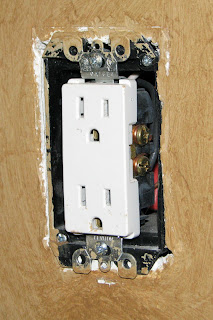There is one simple upgrade that almost every house will benefit from. You’ll have greater comfort, less drafts, and see energy savings in summer and winter.
What is this simple, low tech upgrade? It is electrical outlet insulation pads (aka wall-plate insulation, or foam gaskets).
 |
| Decora Leviton Style Outlet |
When electricians install power outlets or light switches, they cut a hole in your drywall and leave an area that has no or minimal insulation (see photo at left). This presents an easy path for outside air to enter your home (aka ‘air infiltration’).
In fact, this gap presents such an easy entry point that in many houses you can literally feel the draft on cool and windy days. To demonstrate this point, my new construction house in the Arizona desert (not exactly a location known for cold) was actually quite drafty in the winter until I added my wall-plate insulators.
The solution for this is quite simple – purchase a few packages of foam wall-plate and switch-plate insulators (sometimes called ‘foam gaskets’), and install them.
The biggest ‘trick’ to installing these is actually purchasing the correct type/shape in the first place. the gaskets/insulators are designed to create a tight fit, and made to fit the exact size of the protrusion in the outlet.
Electrical sockets are generally the same in most construction (with some exceptions - especially GFCI outlets). However, switch plates vary drastically depending on the age of your home. Recent construction uses ‘decorator’ or ‘decora leviton’ style switches, which are large, flat, rectangular
shaped rocker switches or outlets. The photo above is a Decora style outlet, which is one of those "exceptions" I just mentioned.
Older construction uses much smaller switches that protrude from the wall a half inch or so. You can either purchase the
Gasket Covers
by themselves, or
part of a kit that includes door sweeps
at Amazon. Note that the kit linked to the left is for the older style outlets and switches. The best source for Decora Leviton style gasket covers seems to be
outletsealers.com.
 |
| Foam Gasket Placed On Outlet |
You can also purchase small packets of insulators from your local hardware store or from a number of online sources. However, your best bet is online sources, where you can purchase bulk quantities at a discount.
As an example, you should be able to find 50 foam gaskets for around $18 or less online, but you'd probably pay double that at the home improvement store. Further, you’ll be more likely to find specialized gaskets to fit those multi-gang switch plates that cover multiple switches.
It’s difficult to estimate payback on this improvement because air infiltration alone is not enough to calculate energy consumed. You would need to know how much air infiltration is occurring, the average temperature deviation from your preferred temperature for that air, and then factor how efficient your heating and air conditioning system is in dealing with that air. So for this one you’ll have to take my word on the value.
Foam Outlet Gasket Installation
Installation could not be much simpler. If you’re like me, if you try to estimate the number of outlets and switches you have on outside facing walls, you will definitely underestimate the quantities. Your best bet is to survey each room and keep a tally.
All it takes is removing the wall plate, inserting the foam (see photo), and then screwing the wall plate back on. Best practice would be to turn off the breaker prior to performing any action with the wall plate.













